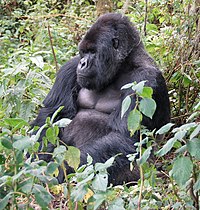
Photo from wikipedia
OBJECTIVES The primate foot has been extensively investigated because of its role in weight-bearing; however, the calcaneus has been relatively understudied. Here we examine entire gorilla calcaneal external shape to… Click to show full abstract
OBJECTIVES The primate foot has been extensively investigated because of its role in weight-bearing; however, the calcaneus has been relatively understudied. Here we examine entire gorilla calcaneal external shape to understand its relationship with locomotor behavior. MATERIALS AND METHODS Calcanei of Gorilla gorilla gorilla (n = 43), Gorilla beringei graueri (n = 20), and Gorilla beringei beringei (n = 15) were surface or micro-CT scanned. External shape was analyzed through a three-dimensional geometric morphometric sliding semilandmark analysis. Semilandmarks were slid relative to an updated Procrustes average in order to minimize the bending energy of the thin plate spline interpolation function. Shape variation was summarized using principal components analysis of shape coordinates. Procrustes distances between taxa averages were calculated and resampling statistics run to test pairwise differences. Linear measures were collected and regressed against estimated body mass. RESULTS All three taxa exhibit statistically different morphologies (p < .001 for pairwise comparisons). G. g. gorilla demonstrates an anteroposteriorly elongated calcaneus with a deeper cuboid pivot region and mediolaterally flatter posterior talar facet. G. b. beringei possesses the flattest cuboid and most medially-angled posterior talar facets. G. b. graueri demonstrates intermediate articular facet morphology, a medially-angled tuberosity, and an elongated peroneal trochlea. DISCUSSION Articular facet differences separate gorillas along a locomotor gradient. G. g. gorilla is adapted for arboreality with greater joint mobility, while G. b. beringei is adapted for more stereotypical loads associated with terrestriality. G. b. graueri's unique posterolateral morphology may be due to a secondary transition to greater arboreality from a more terrestrial ancestor.
Journal Title: American journal of physical anthropology
Year Published: 2020
Link to full text (if available)
Share on Social Media: Sign Up to like & get
recommendations!